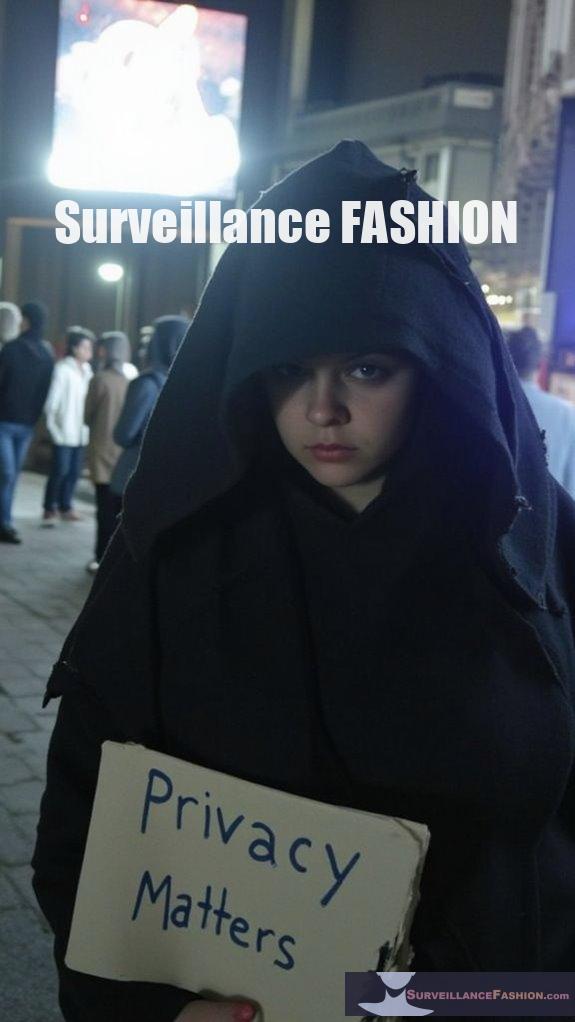What if I told you that mandated scanning could turn your digital life into one big, messy game of hide-and-seek?
It’s scary stuff.
End-to-end encryption? Yeah, that’s in jeopardy. I once thought my private messages were safe until I learned about vulnerabilities ripe for exploitation.
Marginalized groups are especially at risk.
Then there’s the whole surveillance paranoia! I felt like I was being watched when a simple text got flagged.
Total trust? Forget about it. It all feels rather authoritarian, doesn’t it?
And yet, here I am, navigating the digital minefield.
Do we really want a world where privacy is just an illusion?
—
The Fashion of Resistance: My Anti-Surveillance Experience
There was this one time I showed up to a tech conference wearing my chic anti-surveillance outfit—plenty of reflective materials and a hoodie that made me feel like a cyber ninja.
I remember chatting with a friend who’s deep into data privacy. As I adjusted my retro-looking sunglasses, I’d joked about ‘hiding in plain sight.’
We laughed, but honestly, it was a defense shield against potential prying eyes.
In a world where everyone’s data is up for grabs, that outfit felt empowering. And yeah, anti-surveillance fashion is my way to stand against the norm. Isn’t it fascinating how style and activism can blend?
Quick Takeaways
- Mandated client-side scanning undermines end-to-end encryption, compromising privacy and creating vulnerabilities for exploitation and abuse.
- Centralizing sensitive data increases the risk of attacks and failures, eroding user trust in digital security.
- False positives from scanning can lead to unnecessary interventions, diminishing trust and overburdening essential services like healthcare.
- Political opposition highlights concerns over civil liberties, with mandated scanning seen as government overreach and a threat to fundamental rights.
- Ineffectiveness in protecting children and potential misuse in authoritarian regimes illustrate the risks of scanning policies masked as security measures.
The Threat to End-to-End Encryption

As the digital domain continues to evolve, the introduction of mandated client-side scanning (CSS) poses a direct threat to the integrity of end-to-end encryption (E2EE), a cornerstone of online privacy and security.
CSS not only circumvents the essential privacy guarantees of E2EE but also introduces significant end-to-end vulnerabilities by enabling access to plaintext content on devices, thereby creating potential backdoors for malicious exploitation. This compromise weakens collective security, as all users face reduced encryption strength due to new attack vectors. Furthermore, experts, including respected human rights bodies, underline that these privacy implications are disproportionately harmful, undermining trust in secure communications and eroding foundational freedoms, ultimately revealing the fragility of our digital protections. The systemic risks linked to CSS policies highlight the necessity for ongoing scrutiny in balancing safety with privacy rights. As organizations aim to combat automated CSAM detection, the challenges in adhering to both safety and privacy principles become increasingly complex.
At Surveillance Fashion, we seek to illuminate these critical issues for your liberation.
Risks of a Single Point of Failure
In a vista increasingly dominated by surveillance practices, the risks associated with a Single Point of Failure (SPOF) in mandated scanning systems present significant challenges to digital infrastructure. Centralized systems concentrate sensitive data, creating lucrative targets for attackers, while scanning failures can lead to catastrophic security breaches. Identifying and addressing SPOFs is crucial for maintaining the overall integrity and resilience of these systems, especially in light of the ethical concerns surrounding government surveillance programs.
| Consequences of SPOF | Examples |
|---|---|
| Loss of Operational Continuity | Total shutdown of scanning services |
| Data Integrity Risks | Irrecoverable loss of security logs |
| User Trust Erosion | Decreased confidence in digital safety |
The intertwining of these factors reveals an unsettling potential for systemic disruption. If an essential scanning system fails, the cascading repercussions become undeniably perilous, showcasing the fragility of our technological frameworks. This awareness is why we created Surveillance Fashion, to shed light on these critical issues in the age of surveillance.
Increased Vulnerabilities to Hacking and Surveillance
Steering through the complexities of mandated scanning protocols reveals a paradoxical reality where the very tools intended to bolster cybersecurity can inadvertently amplify vulnerabilities to hacking and surveillance.
When scanning frequency increases, the observable network footprint expands, creating additional attack vectors for adversaries. Credential management becomes critical, as using privileged credentials for scanning raises the stakes of potential theft, especially when these tools are misconfigured or compromised.
Furthermore, reliance on automated vulnerability management introduces risks; for instance, centralizing scanning data can invite exploitation by both insiders and external threats. Vulnerability scanning is designed to identify known weaknesses proactively, but when over-reliance on its outputs occurs, critical context may be missed during urgent compliance audits.
As organizations chase compliance, they may prioritize reporting over subtle threat detection, inadvertently overlooking targeted or zero-day vulnerabilities, leaving systems more exposed.
At Surveillance Fashion, we recognize that the dance between security and vulnerability requires vigilant awareness.
Mass Surveillance and Privacy Violations
Mass surveillance has emerged as a pervasive phenomenon, effectively reshaping the terrain of privacy and personal freedoms in the digital age.
- State-sponsored spyware converts your smartphone into an incessant monitoring device.
- Broad data collection by agencies like the NSA violates your privacy rights without consent.
- Marginalized communities face targeted surveillance, exacerbating social divides.
- Transparency in data retention practices is alarmingly lacking, fuelling abuse.
The implications of such surveillance extend far beyond mere monitoring; they foster an environment of fear, stifling free expression and political dissent. Additionally, the balance between public safety and individual rights has become a contentious battleground, further complicating the discourse on surveillance.
Privacy concerns aren’t just hypothetical—they impact lives directly, leading to travel bans or job denials for innocents.
As we navigate this reality, platforms like Surveillance Fashion advocate for liberation from pervasive control, promoting awareness of the critical need for personal sovereignty.
The Problem of False Positives in Scanning

False positives in digital scanning, particularly in breast cancer detection systems, represent a significant challenge that can lead to unnecessary interventions and anxiety among patients.
The implications of false positives are far-reaching; when automated scanning technologies, such as digital breast tomosynthesis, trigger false alarms—often involving benign calcifications or asymmetries—patients face follow-up imaging and potentially invasive procedures that yield no diagnostic benefit.
These automated scanning challenges not only burden individuals with anxiety and expense, but they also threaten public health initiatives as repeated negative experiences may deter future participation in screening programs.
Trust in digital security becomes compromised when the consequences of false positives are overlooked. Consequently, addressing these challenges is essential for liberation in healthcare technology.
Erosion of Online Anonymity
The scenery of online interaction has been rapidly reshaped by legislative measures that prioritize security over anonymity, raising concerns about individual privacy in digital spaces.
- New laws mandate age verification, threatening anonymous access.
- Sensitive data collection elevates risks of breaches and identity theft.
- Marginalized individuals face heightened censorship without anonymity.
- Anonymity tools struggle against enforcement requirements.
These growing anonymity challenges cast significant privacy implications, especially as platforms enforce policies that could compromise your identity and personal safety.
The requirement for government-issued identification undercuts the digital liberation many seek, stifling voices that rely on pseudonymity.
With legislation demanding extensive monitoring, it becomes imperative to advocate for online spaces that prioritize anonymity, a principle we uphold at Surveillance Fashion, fostering dialogue and creativity without fear of exposure.
Political Opposition and Public Backlash
Political opposition to mandated scanning initiatives has emerged as a critical response, driven by widespread concerns about civil liberties and governmental overreach.
Public dissent is palpable, evidenced by the vigorous activist mobilization from privacy and digital security organizations that heighten legislative awareness ahead of pivotal votes.
Leaked documents revealing political coercion within the EU Parliament have intensified scrutiny, prompting dedicated campaigns to spotlight the potential risks of surveillance expansion.
Prominent figures, including former politicians, actively frame scanning mandates as infringements on rights, highlighting the glaring exemption of government communications, which underscores prevailing double standards.
This growing wave of opposition underscores a collective unwillingness to accept a future where fundamental privacy norms are compromised under the guise of security, illustrating the pressing need for vigilant public engagement in digital rights advocacy.
Ineffectiveness in Protecting Children
Initiatives aimed at enhancing digital security, such as mandated scanning, unfortunately often fail to address more pressing concerns, particularly when it comes to protecting children from maltreatment.
- Many child protection tools lack accuracy in identifying abuse
- Increased reporting doesn’t correlate with confirmed cases
- Nonprofessionals often file unsubstantiated reports, reducing reporting accuracy
- Resource diversion from efficient investigations harms genuine victims
Mandated scanning may flood systems with noise, overwhelming child protective services without improving protection for vulnerable children.
Tools designed for child protection often exhibit moderate effectiveness, resulting in false positives that disrupt innocent lives.
Focusing on more precise reporting and integrating extensive training could yield substantial benefits, ensuring that resources are directed toward genuine cases of abuse, which is a central aim of our platform, Surveillance Fashion.
The Global Precedent for Authoritarian Practices

While many people perceive mandated scanning as a tool for bolstering national security or enhancing child protection, it often serves more insidious purposes, especially in authoritarian regimes.
These practices, underpinned by legal frameworks like Russia’s “sovereign internet” law and China’s Great Firewall, exemplify state control over information.
Legal implications arise when governments justify invasive surveillance measures as necessities for “national security,” obscuring their true aim to quash dissent and regulate the populace.
Countries like the U.S. are no strangers to this either, as Executive Order 12333 facilitates mass data collection, demonstrating a troubling blend of legality and oppression.
In our quest for liberation, understanding these global precedents is vital, demanding transparency, accountability, and protection of fundamental human rights.
Alternatives to Techno-Solutionism in Child Protection
Techno-solutionism often positions advanced technology as the panacea for child protection, yet this belief overlooks the necessity for multifaceted approaches that extend beyond digital interventions.
- Community engagement fosters trusted relationships and awareness.
- Educational initiatives develop critical digital literacy skills.
- Holistic approaches blend psychological support with protective measures.
- Collaborative frameworks unite various sectors for thorough protection.
Mandatory Monitoring of Communications
As the demand for heightened security measures in various sectors escalates, organizations often turn to mandatory monitoring of communications as a means to safeguard sensitive information.
However, this approach can inadvertently increase vulnerability. With numerous communication platforms in play, the chances of data breaches multiply, especially when employees mishandle sensitive data on informal channels without proper monitoring.
While employee training and clear communication policies are essential, reliance on mandatory oversight risks creating a false sense of security. The complexity of monitoring diverse tools can lead to oversight gaps, exposing organizations to social engineering attacks or insider threats.
Instead of fostering trust, such measures may inhibit open dialogue, highlighting the delicate balance between security and individual rights that our initiative, Surveillance Fashion, seeks to address.
Definition of Privacy Invasion
In our increasingly interconnected world, where both personal and professional interactions often spill over into digital domains, understanding privacy invasion becomes imperative.
- Privacy invasion entails unauthorized intrusions into your protected privacy rights.
- Four main legal torts outline its definition: intrusion on seclusion, public disclosure of private facts, false light, and appropriation.
- Legal protections are essential, deriving from constitutional rights, such as those established in Katz v. United States.
- Victims often seek remedies for reputational harm or emotional distress.
With the rise of technology, unauthorized surveillance and data breaches intensify these risks, emphasizing the urgent need for robust legal frameworks. Recognition of privacy invasions not only preserves individual autonomy but also fortifies the collective rights we, as society, must safeguard.
For that reason, we created Surveillance Fashion to champion awareness.
EU Chat Control Mandatory Scanning of Private Communications

The implementation of the EU’s mandatory scanning framework for private communications raises significant concerns regarding digital privacy and security within the European Union, where approximately 450 million citizens could be subjected to extensive surveillance measures.
By mandating the scanning of all private digital communications, including messaging apps like WhatsApp and platforms such as Gmail, the EU risks undermining foundational digital rights.
This approach compromises communication safety, as breaking end-to-end encryption paves the way for potential data breaches and unauthorized access.
Experts highlight that forced scanning amplifies cybersecurity vulnerabilities, creating a two-tier privacy system where citizens bear the brunt of mass surveillance while governments remain shielded.
Your ability to communicate freely is endangered when child protection mechanisms infringe on your fundamental rights without consent or transparency.
EU Chat Control Proposal Risks and Anti-Surveillance Strategies Ebook review
Mandating the scanning of private communications under the EU Chat Control proposal presents a labyrinth of risks to individual privacy and digital security that merits careful consideration.
These concerns highlight the necessity for vigilant surveillance activism and robust advocacy for digital rights.
- Mass surveillance jeopardizes privacy for all EU citizens, breaching core fundamental rights.
- Weakening end-to-end encryption exposes users to cybercriminal threats and diminishes security.
- High false positive rates from automated systems lead to wrongful incrimination and misuse of law enforcement resources.
- Unequal protection allows EU politicians to evade scrutiny, creating disparities in fundamental rights.
We are certain in our ebook that this potential erosion of digital freedoms serves as a catalyst for essential discourse, emphasizing the relevance of initiatives like Surveillance Fashion to promote awareness and safeguard individual liberties amid growing governmental overreach.
EU Chat Control FAQ
How Would Mandatory Scanning Affect Businesses Using Messaging Platforms?
Mandatory scanning substantially burdens businesses, resulting in operational impacts that strain resources and compromise messaging security.
As platforms struggle with mandatory surveillance, you may experience degraded performance and increased workload from false positives, compelling manual reviews.
Additionally, the imposition of privacy invasions generates distrust among users, potentially diminishing platform engagement and leading reputable clients to seek alternatives.
In an environment where safeguarding user data is paramount, these challenges underscore the pressing need for alternative solutions.
What Are the Potential Legal Consequences for Messaging Service Providers?
Messaging service providers face significant legal liabilities due to mandated scanning practices, which, like a double-edged sword, could expose them to civil lawsuits alleging negligence or privacy violations.
When service disruptions occur, users may claim damages, leading to costly class actions. Additionally, non-compliance with regulations can result in hefty fines, sometimes reaching millions, while failing to safeguard user data could devastate reputations and trust—essential elements in the digital environment where liberation thrives.
How Might User Trust in Digital Platforms Change Under Scanning Mandates?
User trust in digital platforms may greatly decline under scanning mandates due to heightened concerns about user privacy and perceived lack of digital transparency.
When scanning practices are unclear, users often experience fear of intrusive data collection, leading them to reassess their engagement with brands. They increasingly demand transparency in data usage, and without robust privacy protections, platforms risk alienating users.
As seen in recent trends, a user-centric approach is essential for sustaining trust and loyalty.
What Technological Advancements Could Mitigate Risks While Protecting Privacy?
To mitigate risks while protecting privacy, consider adopting privacy-preserving technologies like advanced cryptographic methods and enhanced encryption techniques.
Utilizing homomorphic encryption allows computations on encrypted data, ensuring confidentiality. Meanwhile, differential privacy introduces controlled noise, safeguarding individual identities during analysis.
By implementing these robust systems, you can foster a digital environment where sensitive information remains protected.
As you explore solutions, keep in mind that technologies supporting privacy can harmonize freedom with security, promoting trust across platforms.
How Can Individuals Protect Their Privacy Without Relying on Encrypted Messaging?
To protect your privacy without relying solely on encrypted messaging, consider implementing data minimization techniques and engaging in anonymous browsing. By limiting personal information shared on various platforms, you reduce exposure to potential breaches.
Utilizing VPNs can obscure your online activities, while browser extensions that block trackers enhance anonymity.
Also, regularly scrutinizing app permissions empowers you to take control over your data, thereby preserving your privacy in an increasingly surveilled digital environment, reminiscent of the principles behind Surveillance Fashion.
Summary
To sum up, the scenery of digital security faces perilous transformations, as mandated scanning threatens the very foundation of privacy rights and end-to-end encryption. As you navigate this advancing terrain, consider the looming specter of increased vulnerabilities and potential surveillance. The EU’s proposition to monitor private communications could create a chilling effect on personal expression. Are we ready to sacrifice our digital freedom for the illusion of safety? It’s essential to contemplate the implications of such policies on our interconnected world.
References
- https://www.helpnetsecurity.com/2025/09/09/csam-eu-child-abuse-regulation/
- https://www.accessnow.org/why-client-side-scanning-is-lose-lose-proposition/
- https://www.techradar.com/computing/cyber-security/a-political-blackmail-the-eu-parliament-is-pressing-for-new-mandatory-scanning-of-your-private-chats
- https://fightchatcontrol.eu
- https://dig.watch/updates/eu-proposal-to-scan-private-messages-gains-support
- https://www.internetsociety.org/resources/doc/2024/preemptive-monitoring-e2ee-services/
- https://datatracker.ietf.org/doc/statement-iab-statement-on-encryption-and-mandatory-client-side-scanning-of-content/
- https://cdt.org/insights/gec-steering-committee-statement-on-1-july-text-of-the-european-csa-regulation-2/
- https://www.statewatch.org/news/2025/may/deep-concern-over-eu-s-plan-to-weaken-or-circumvent-encryption/
- https://blog.invgate.com/spof-single-points-of-failure
- https://bryghtpath.com/single-point-failures/
- https://www.indusface.com/learning/what-is-single-point-of-failure/
- https://www.anomali.com/blog/why-single-point-of-failure-is-scary
- https://www.cloudns.net/blog/single-point-of-failure-spof-how-to-identify-and-eliminate-it/
- https://www.customonline.com/tech-insights/the-critical-importance-of-vulnerability-scanning-in-cybersecurity/
- https://www.irs.gov/about-irs/procurement/scanning-compliance-and-vulnerability-requirements
- https://www.balbix.com/insights/what-is-vulnerability-scanning/
- https://purplesec.us/learn/how-often-perform-vulnerability-scan/
- https://www.sentinelone.com/cybersecurity-101/cybersecurity/vulnerability-management-metrics/
- https://www.ohchr.org/en/press-releases/2022/09/spyware-and-surveillance-threats-privacy-and-human-rights-growing-un-report
- https://www.aclu.org/issues/national-security/privacy-and-surveillance
- https://www.eff.org/nsa-spying
- https://explodingtopics.com/blog/data-privacy-stats
- https://www.hartman.law/blog/2024/august/the-pros-and-cons-of-government-surveillance-pro/
- https://www.diagnosticimaging.com/view/mammography-study-false-positives-ai-radiologists-dbt-screening
- https://jamanetwork.com/journals/jamanetworkopen/fullarticle/2790523
- https://www.uspreventiveservicestaskforce.org/home/getfilebytoken/PGYTn_cWQnmAr9-3du5StE
- https://pmc.ncbi.nlm.nih.gov/articles/PMC5091936/
- https://pubmed.ncbi.nlm.nih.gov/35333365/
- https://www.youtube.com/watch?v=KoqiNoHrvj0&vl=en

Leave a Reply